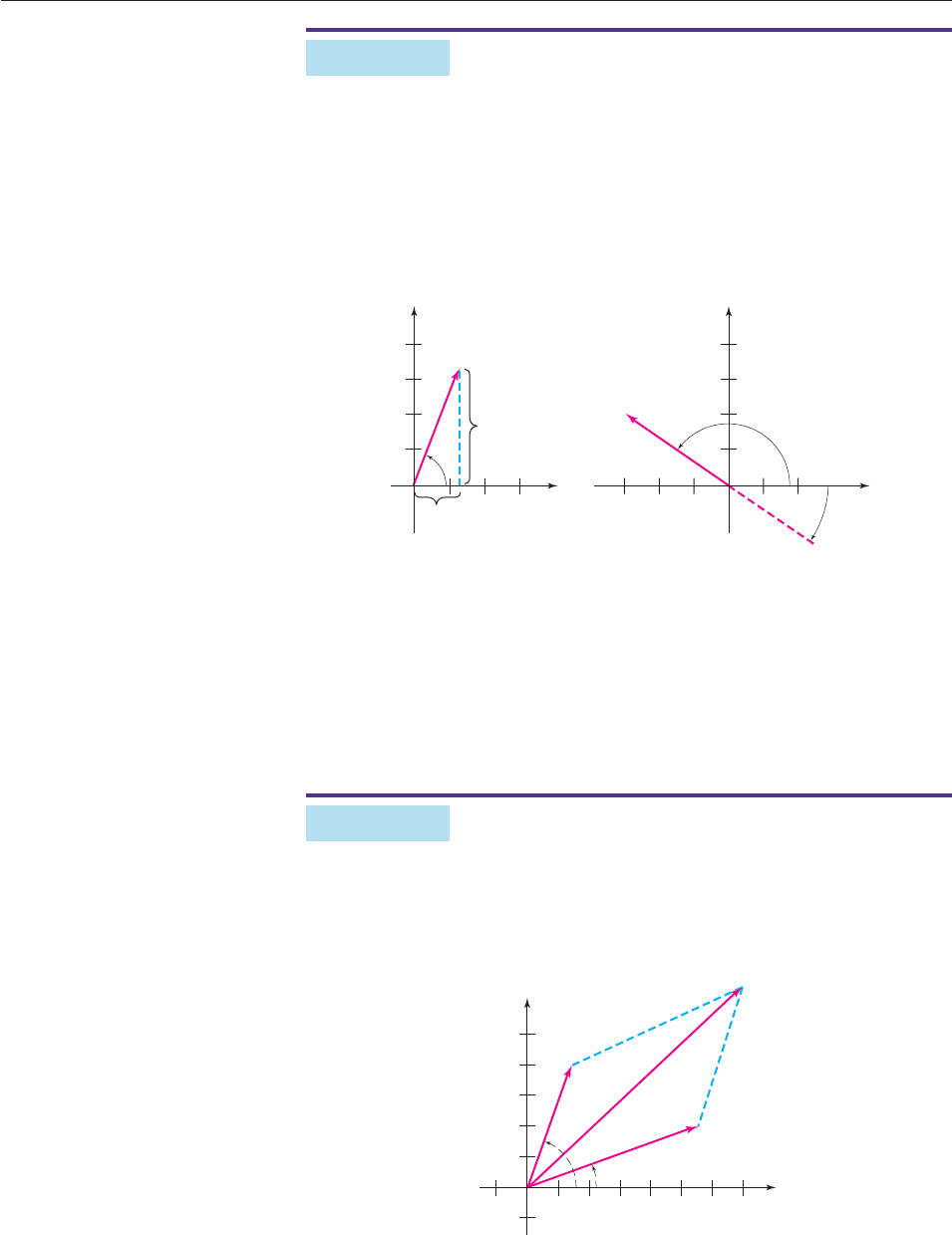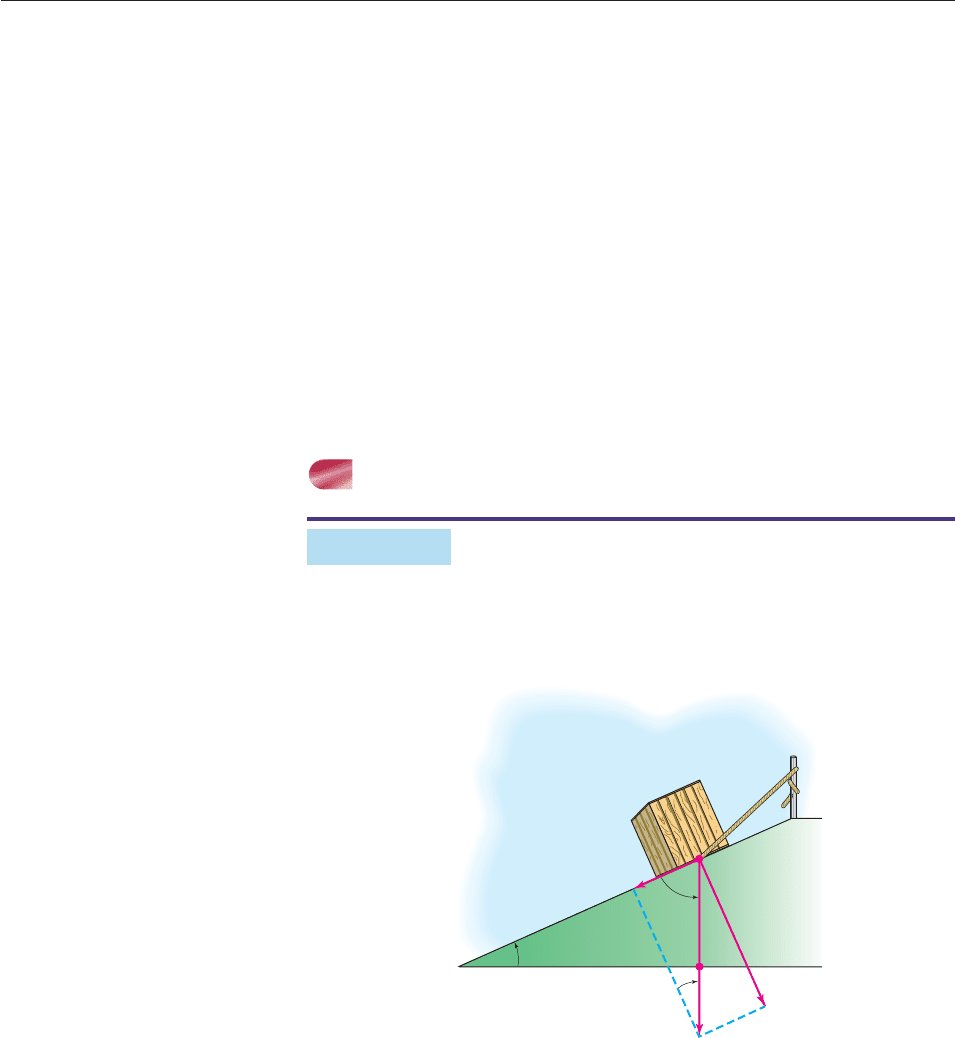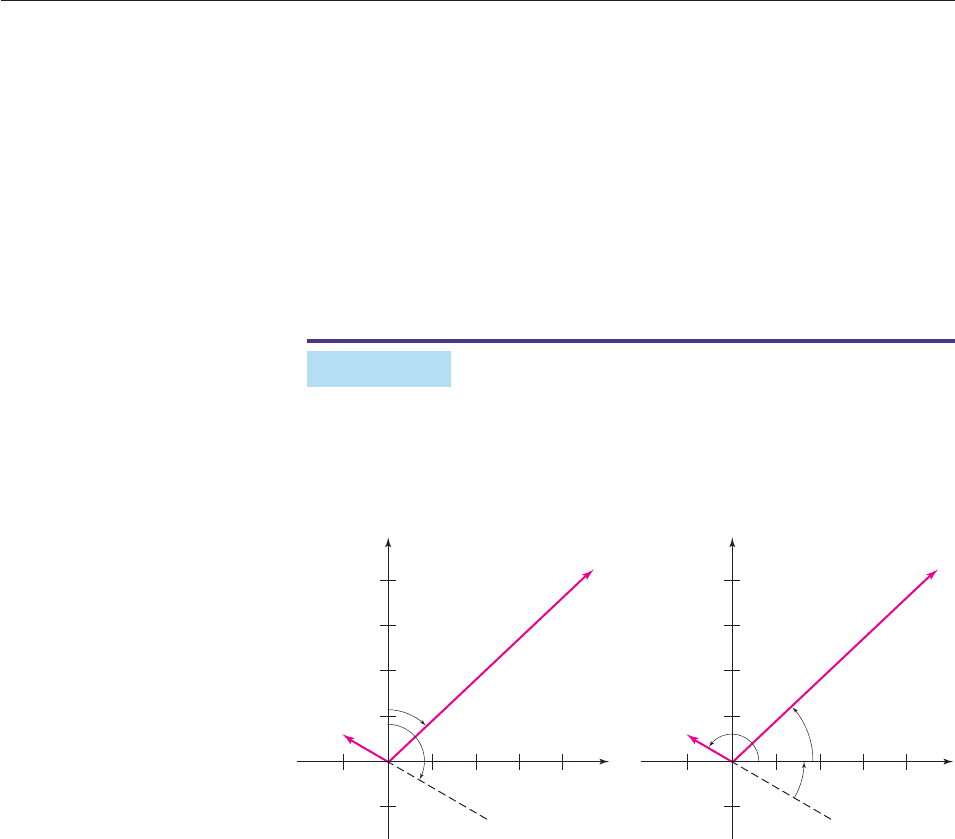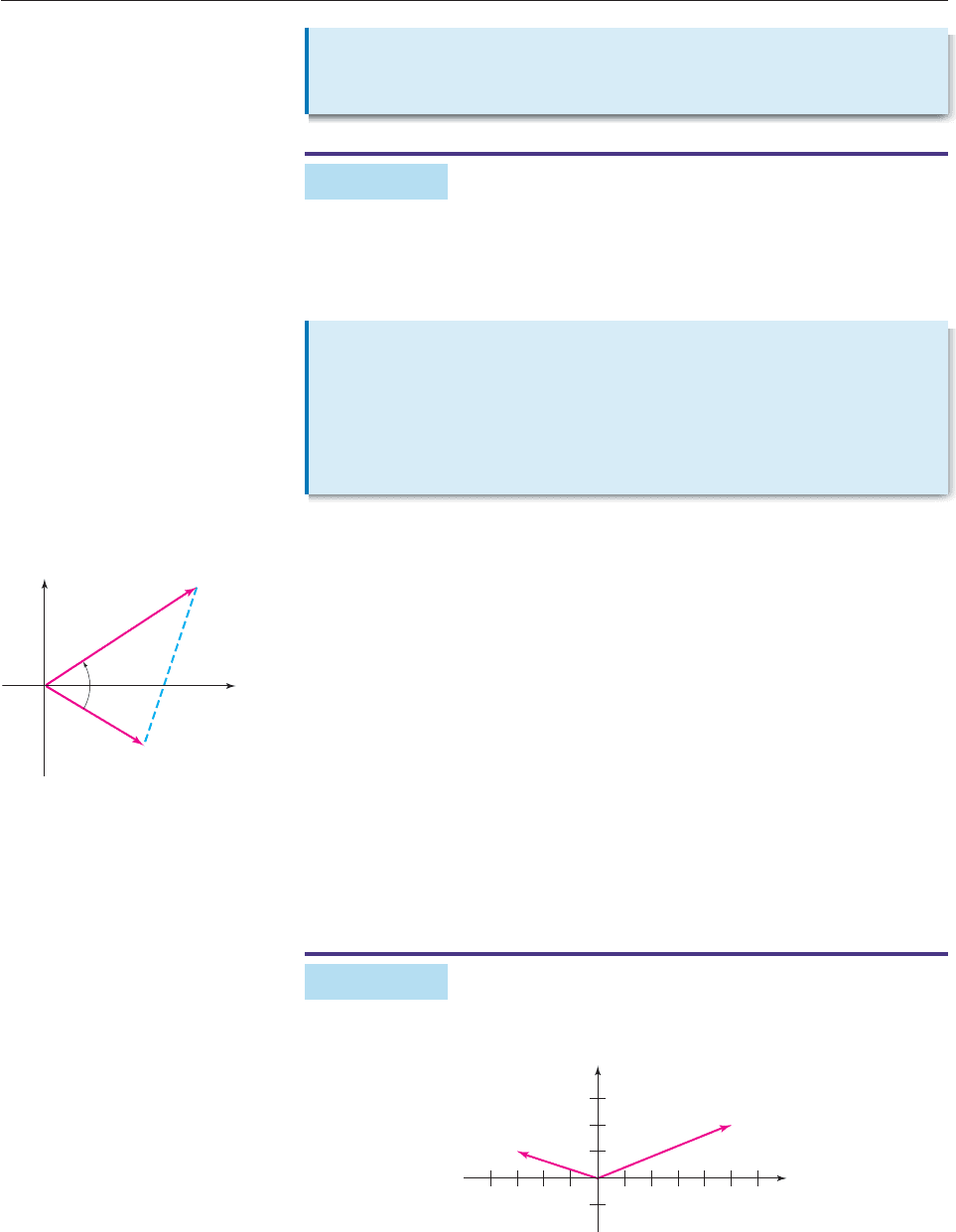Hungerford T.W., Shaw D.J. Contemporary Precalculus: A Graphing Approach
Подождите немного. Документ загружается.


EXAMPLE 7
Find a unit vector that has the same direction as the vector v 5, 12.
SOLUTION The length of v is
v 5, 12
5
2
1
2
2
169
13.
The vector
u
1
1
3
v
1
5
3
,
1
1
2
3
has the same direction as v (since it is a scalar multiple by a positive number), and
u is a unit vector because
u
1
1
3
v
1
1
3
v
1
1
3
13 1. ■
The procedure used in Example 7 (multiplying a vector by the reciprocal of
its length) works in the general case.
You can easily verify that the vectors i 1, 0 and j 0, 1 are unit vectors.
The vectors i and j play a special role because they lead to a useful alternate nota-
tion for vectors. For example, if u 5, 7 then
u 5, 0 0, 7 51, 0 70, 1 5i 7j.
Similarly, if v a, b is any vector, then
v a, b a, 0 0, b a1, 0 b0, 1 ai bj.
The vector v is said to be a linear combination of i and j. When vectors are writ-
ten as linear combinations of i and j, then the properties in the box on page 645
can be used to write the rules for vector addition and scalar multiplication in this
form.
(ai bj) (ci d j) (a c)i (b d)j
and
c(ai bj) cai cbj.
EXAMPLE 8
If u 2i 6j and v 5i 2j, find 3u 2v.
SOLUTION
3u 2v 3(2i 6j) 2(5i 2j) 6i 18j 10i 4j
16i 22j. ■
646 CHAPTER 9 Applications of Trigonometry
TECHNOLOGY TIP
To find a unit vector in the same direc-
tion as v, use UNITV in this menu/sub-
menu:
TI-86: VECTOR/MATH
TI-89: MATH/MATRIX/
VECTOR OPS
Unit
Vectors
If v is a nonzero vector, then
1
v
v is a unit vector with the same direction
as v.

DIRECTION ANGLES
If v a, b ai bj is a vector, then the direction of v is completely deter-
mined by the standard position angle u between 0° and 360° whose terminal side
is v, as shown in Figure 9–16. The angle u is called the direction angle of the
vector v. According to the point-in-the-plane description of the trigonometric
functions,
cos u
a
v
and sin u
b
v
.
Rewriting each of these equations produces the following result.
EXAMPLE 9
Find the component form of the vector that represents the velocity of an airplane
at the instant its wheels leave the ground if the plane is going 60 mph and the body
of the plane makes a 7° angle with the horizontal.
SOLUTION The velocity vector v ai bj has magnitude 60 and direction
angle u 7°, as shown in Figure 9–17. Hence,
v (v cos u)i (v sin u)j
(60 cos 7°)i (60 sin 7°)j
(60
.9925)i (60
.1219)j
59.55i 7.31j 59.55, 7.31. ■
Figure 9–17
If v ai bj is a nonzero vector with direction angle u, then
tan u
c
s
o
in
s
u
u
b
a
/
/
v
v
b
a
.
This fact provides a convenient way to find the direction angle of a vector.
x
v
y
10 30
7°
60
10
50
SECTION 9.3 Vectors in the Plane 647
〈a, b〉
x
v
θ
y
b
a
Figure 9–16
Components of the
Direction Angle
If v a, b ai bj, then
a v cos u and b v sin u
where u is the direction angle of v.

EXAMPLE 10
Find the direction angle of
(a) u 5i 13j (b) v 10i 7j.
SOLUTION
(a) The direction angle u of u satisfies tan u b/a 13/5 2.6. Using the
TAN
1
key on a calculator, we find that u 68.96°, as shown in Fig-
ure 9–18(a).
Figure 9–18
(b) The direction angle of v satisfies tan u 7/10 .7. Since v lies in the
second quadrant, u must be between 90° and 180°. A calculator shows that
34.99° is an angle with tangent (approximately) .7. Since tangent has pe-
riod p( 180°), we know that tan t tan(t 180°) for every t. Therefore,
u 34.99° 180° 145.01° is the angle between 90° and 180° such that
tan u .7. See Figure 9–18(b). ■
EXAMPLE 11
An object at the origin is acted upon by two forces. A 150-pound force makes an
angle of 20° with the positive x-axis, and the other force of 100 pounds makes an
angle of 70°, as shown in Figure 9–19. Find the direction and magnitude of the
resultant force.
Figure 9–19
50
100
70°
20°
50
O
R
Q
P
100 150
x
y
4
u
4
8
12
16
8
5
(a) (b)
〈5, 13〉
13
θ
x
y
v
4
8
–4
145.01°
–34.99°
–8–12
〈–10, 7〉
x
y
648 CHAPTER 9 Applications of Trigonometry

SOLUTION The forces acting on the object are
OP
(100 cos 70°)i (100 sin 70°)j,
OQ
(150 cos 20°)i (150 sin 20°)j.
The resultant force OR
is the sum of OP
and OQ
. Hence,
OR
(100 cos 70° 150° cos 20°)i (100 sin 70° 150 sin 20°)j
175.16i 145.27j.
Therefore, the magnitude of the resultant force is
OR
(175.1
6)
2
(145.2
7)
2
227.56.
The direction angle u of the resultant force satisfies
tan u 145.27/175.16 .8294.
A calculator shows that u 39.67°. ■
APPLICATIONS
EXAMPLE 12
A 200-pound box lies on a ramp that makes an angle of 24° with the horizontal. A
rope is tied to the box from a post at the top of the ramp to keep it in position.
Ignoring friction, how much force is being exerted on the rope by the box?
Figure 9–20
SOLUTION Because of gravity, the box exerts a 200-pound weight straight
down (vector TR
). As Figure 9–20 shows, TR
is the sum of TP
and TQ
. The force
on the rope is exerted by TP
, the vector of the force pulling the box down the
ramp, so we must find TP
. In right triangle TSC, a 24° 90°, and in right
triangle TPR, a u 90°. Hence,
a u a 24°; hence, u 24°.
C
24°
θ
R
Q
S
P
T
α
SECTION 9.3 Vectors in the Plane 649

Therefore,
sin u
2
T
0
P
0
sin 24°
TP
200 sin 24° 81.35.
So the force on the rope is 81.35 pounds. ■
In aerial navigation, directions are given in terms of the angle measured in
degrees clockwise from true north. Thus, north is 0°, east is 90°, and so on.
EXAMPLE 13
An airplane is traveling in the direction 50° with an air speed of 300 mph, and
there is a 35-mph wind from the direction 120°, as represented by the vectors
p and w in Figure 9–21(a). Find the course and ground speed of the plane (that is,
its direction and speed relative to the ground).
Figure 9–21
SOLUTION The course of the plane is the direction of the vector p w, and
its ground speed is the magnitude of p w. Figure 9–21(b) shows that the direc-
tion angle of p (the angle it makes with the positive x-axis) is 40° and that the
direction angle of w is 150°. Therefore,
p w [(300 cos 40°)i (300 sin 40°)j] [(35 cos 150°)i (35 sin 150°)j]
(300 cos 40° 35 cos 150°)i (300 sin 40° 35 sin 150°)j
199.50i 210.34j.
The direction angle of p w satisfies tan u 210.34/199.50 1.0543, and a
calculator shows that u 46.5°. This is the angle p w makes with the positive
x-axis; hence, the course of the plane (the angle between true north and p w) is
90° 46.5° 43.5°. The ground speed of the plane is
p w
(199.5
)
2
(2
10.34)
2
289.9 mph. ■
120
240
50°
120°
p
w
240
(a)
–60
x
y
120
240
40°
30°
150°
p
w
240
(b)
–60
x
y
TP
TR
650 CHAPTER 9 Applications of Trigonometry

SECTION 9.3 Vectors in the Plane 651
EXERCISES 9.3
In Exercises 1–4, find the magnitude of the vector PQ
.
1. P (2, 3), Q (5, 9)
2. P (3, 5), Q (7, 11)
3. P (7, 0), Q (4, 5)
4. P (30, 12), Q (25, 5)
In Exercises 5–10, find a vector with the origin as initial point
that is equivalent to the vector PQ
.
5. P (1, 5), Q (7, 11)
6. P (2, 7), Q (2, 9)
7. P (4, 8), Q (10, 2)
8. P (5, 6), Q (7, 9)
9. P
4
5
, 2
, Q
1
5
7
,
1
5
2
10. P (2
, 4), Q (3
, 1)
In Exercises 11–20, find u v, v u, and 2u 3v.
11. u 2, 4, v 6, 1
12. u 4, 0, v 1, 3
13. u 3, 3 2
, v 4 2
, 1
14. u
2
3
, 4
, v
7,
1
3
9
15. u 22, 5, v
1
4
7, 12
16. u i j, v 2i j
17. u 8i, v 2(3i 2j)
18. u 4(i j), v 3i
19. u
2i
3
2
j
, v
3
4
i
20. u 2
j, v 3
i
In Exercises 21–26, find the components of the given vector,
where u i 2j, v 3i j, w 4i j.
21. u 2w 22.
1
2
(3v w)
23.
1
2
w 24. 2u 3v
25.
1
4
(8u 4v w) 26. 3(u 2v) 6w
In Exercises 27–34, find the component form of the vector v
whose magnitude and direction angle u are given.
27. v 4, u 0° 28. v 5, u 30°
29. v 10, u 225° 30. v 20, u 120°
31. v 6, u 40° 32. v 8, u 160°
33. v 1/2, u 250° 34. v 3, u 310°
In Exercises 35–42, find the magnitude and direction angle of
the vector v.
35. v 4, 4 36. v 5, 5 3
37. v 8, 0 38. v 4, 5
39. v 6j 40. v 4i 8j
41. v 2i 8j 42. v 15i 10j
In Exercises 43–46, find a unit vector that has the same
direction as v.
43. 4, 5 44. 7i 8j
45. 5i 10j 46. 3i 9j
In Exercises 47–50, an object at the origin is acted upon by two
forces, u and v, with direction angle u
u
and u
v
, respectively.
Find the direction and magnitude of the resultant force.
47. u 30 pounds, u
u
0°; v 90 pounds, u
v
60°
48. u 6 pounds, u
u
45°; v 6 pounds, u
v
120°
49. u 12 newtons, u
u
130°; v 20 newtons u
v
250°
50. u 30 newtons, u
u
300°; v 80 newtons, u
v
40°
If forces u
1
, u
2
, . . . , u
k
act on an object at the origin, the result-
ant force is the sum u
1
u
2
u
k
. The forces are said to
be in equilibrium if their resultant force is 0. In Exercises 51
and 52, find the resultant force and find an additional force v
that, if added to the system, produces equilibrium.
51. u
1
2, 5, u
2
6, 1, u
3
4, 8
52. u
1
3, 7, u
2
8, 2, u
3
9, 0, u
4
5, 4
In Exercises 53–58, let u a, b and v c, d, and let r and
s be scalars. Prove that the stated property holds by calculat-
ing the vector on each side of the equal sign.
53. v 0 v 0 v
54. v (v) 0
55. r(u v) ru rv
56. (r s)v rv sv
57. (rs)v r(sv) s(rv)
58. 1v v and 0v 0
59. Two ropes are tied to a wagon. A child pulls one with a force
of 20 pounds while another child pulls the other with a force
of 30 pounds (see figure on the next page). If the angle be-
tween the two ropes is 28°, how much force must be exerted
by a third child, standing behind the wagon, to keep the
wagon from moving? [Hint: Assume that the wagon is at the

652 CHAPTER 9 Applications of Trigonometry
origin and one rope runs along the positive x-axis. Proceed
as in Example 11 to find the resultant force on the wagon
from the ropes. The third child must use the same amount in
the opposite direction.]
60. Two circus elephants, Bessie and Maybelle, are dragging a
large wagon, as shown in the figure. If Bessie pulls with a
force of 2200 pounds and Maybelle with a force of
1500 pounds and the wagon moves along the dashed line,
what is angle u?
Exercises 61–64 deal with an object on an inclined plane. The
situation is similar to that in Figure 9–20 of Example 12, where
TP
is the component of the weight of the object parallel to the
plane and TQ
is the component of the weight perpendicular
to the plane.
61. An object weighing 50 pounds lies on an inclined plane that
makes a 40° angle with the horizontal. Find the components
of the weight parallel and perpendicular to the plane. [Hint:
Solve an appropriate triangle.]
62. Do Exercise 61 when the object weighs 200 pounds and the
inclined plane makes a 20° angle with the horizontal.
63. If an object on an inclined plane weighs 150 pounds and the
component of the weight perpendicular to the plane is 60
pounds, what angle does the plane make with the horizontal?
64. A force of 500 pounds is needed to pull a cart up a ramp that
makes a 15° angle with the ground. Assume that no friction
is involved, and find the weight of the cart. [Hint: Draw a
picture similar to Figure 9–20; the 500-pound force is par-
allel to the ramp.]
24°
θ
Bessie
Maybelle
20 lb
30 lb
28
˚
In Exercises 65–68, find the course and ground speed of the
plane under the given conditions. (See Example 13.)
65. Air speed 250 mph in the direction 60°; wind speed
40 mph from the direction 330°.
66. Air speed 400 mph in the direction 150°; wind speed
30 mph from the direction 60°.
67. Air speed 300 mph in the direction 300°; wind speed
50 mph in (not from) the direction 30°.
68. Air speed 500 mph in the direction 180°; wind speed
70 mph in the direction 40°.
69. The course and ground speed of a plane are 70° and
400 mph, respectively. There is a 60-mph wind blowing south.
Find the (approximate) direction and air speed of the plane.
70. A plane is flying in the direction 200° with an air speed of
500 mph. Its course and ground speed are 210° and 450 mph,
respectively. What are the direction and speed of the wind?
71. A river flows from east to west. A swimmer on the south
bank wants to swim to a point on the opposite shore directly
north of her starting point. She can swim at 2.8 mph, and
there is a 1-mph current in the river. In what direction should
she head so as to travel directly north (that is, what angle
should her path make with the south bank of the river)?
72. A river flows from west to east. A swimmer on the north
bank swims at 3.1 mph along a straight course that makes a
75° angle with the north bank of the river and reaches the
south bank at a point directly south of his starting point.
How fast is the current in the river?
73. A 400-pound weight is suspended by two cables (see fig-
ure). What is the force (tension) on each cable? [Hint: Imag-
ine that the weight is at the origin and that the dashed line is
the x-axis. Then cable v is represented by the vector
(c cos 65°)i (c sin 65°)j, which has magnitude c (why?).
Represent cable u similarly, denoting its magnitude by d.
Use the fact that u v 0i 400j (why?) to set up a sys-
tem of two equations in the unknowns c and d.]
v
u
32°
65°
400

SECTION 9.4 The Dot Product 653
74. An 800-pound weight is suspended from two cables, as
shown in the figure. What is the tension (force) on each
cable? [See the Hint for Exercise 73.]
75. Do Exercise 74 when the weight is 600 pounds and the an-
gles are 28° and 38°.
76. A 175-pound high-wire artist stands balanced on a
tightrope, which sags slightly at the point where he is stand-
ing. The rope in front of him makes a 6° angle with the hor-
izontal, and the rope behind him makes a 4° angle with the
horizontal. Find the force on each end of the rope. [Hint:
Use a picture and procedure similar to that in Exercise 73.]
77. Let v be the vector with initial point (x
1
, y
1
) and terminal
point (x
2
, y
2
), and let k be any real number.
(a) Find the component form of v and kv.
(b) Calculate v and kv.
(c) Use the fact that
k
2
k to verify that kv k
v.
(d) Show that tan u tan b, where u is the direction angle
of v and b is the direction angle of kv. Use the fact that
tan t tan(t 180°) to conclude that v and kv have ei-
ther the same or opposite directions.
(e) Use the fact that (c, d ) and (c, d) lie on the same
straight line on opposite sides of the origin (Exercise 85
in Section 1.3) to verify that v and kv have the same di-
rection if k 0 and opposite directions if k 0.
32°
48°
78. Let u a, b, v c, d. Verify the accuracy of the two
geometric interpretations of vector addition given on page
644 as follows.
(a) Show that the distance from (a, b) to (a c, b d) is
the same as v.
(b) Show that the distance from (c, d ) to (a c, b d) is
the same as u.
(c) Show that the line through (a, b) and (a c, b d) is
parallel to v by showing they have the same slope.
(d) Show that the line through (c, d) and (a c, b d) is
parallel to u.
79. Let u a, b and v c, d. Show that u v is equivalent
to the vector w with initial point (c, d ) and terminal point
(a, b) as follows. (See the figure.)
(a) Show that u v w.
(b) Show that u v and w have the same direction.
(c, d)
(a, b)
(a – b, c – d)
x
u
u – v
v
–v
w
y
9.4 The Dot Product
Section Objectives
Dot
Product
The dot product of vectors u a, b ai bj and v c, d ci dj
is denoted u
v and is defined to be the real number ac bd. Thus,
u
v ac bd.
■ Find the dot product of two vectors.
■ Find the angle between two vectors.
■ Determine when two vectors are parallel or orthogonal.
■ Find the projections and components of a pair of vectors.
■ Use vectors to solve application problems.
When two vectors are added, their sum is another vector, but the situation is different
with products. The dot product of two vectors is the real number defined as follows.

EXAMPLE 1
(a) If u 5, 3 and v 2, 6, then
u
v 5(2) 3
6 8.
(b) If u 4i 2j and v 3i j, then
u
v 4
3 (2)(1) 14.
(c) 2, 4
6, 3 2
6 (4)3 0. ■
The dot product has a number of useful properties.
Proof
1. If u a, b, then
u
a
2
b
2
.
Hence,
u
u a, b
a, b a
a b
b a
2
b
2
(
a
2
b
2
)
2
u
2
.
2. If u a, b and v c, d, then
u
v a, b
c, d ac bd ca db c, d
a, b v
u.
The last three statements are proved similarly (Exercises 37–39.) ■
ANGLES
If u a, b and v c, d are nonzero vectors, then the angle between u and v
is the smallest angle u formed by these two line segments, as shown in Fig-
ure 9–22. We ignore clockwise or counterclockwise rotation and consider the
angle between v and u to be the same as the angle between u and v. Thus, the
radian measure of u ranges from 0 to p.
Nonzero vectors u and v are said to be parallel if the angle between them is
either 0 or p radians (that is, u and v lie on the same straight line through the ori-
gin and have either the same or opposite directions). The zero vector 0 is consid-
ered to be parallel to every vector.
Any scalar multiple of u is parallel to u, since it lies on the same straight line
as u (see Example 3 in Section 9.3). Conversely, if v is parallel to u, it is easy to
show that v must be a scalar multiple of u (Exercise 40). Hence, we have the
following.
654 CHAPTER 9 Applications of Trigonometry
TECHNOLOGY TIP
To compute dot products use DOT or
DOTP in this menu/submenu:
TI-86: VECTOR/MATH
TI-89: MATH/MATRIX/VECTOR OPS
HP-39gs: MATH/MATRIX
Properties of
the Dot Product
If u, v, w are vectors and k is a real number, then
1. u
u u
2
.
2. u
v v
u.
3. u
(v w) u
v u
w.
4. ku
v k(u
v) u
kv.
5. 0
u 0.
u
v
θ
Figure 9–22

EXAMPLE 2
The vectors 2, 3 and 8, 12 are parallel because 8, 12 42, 3. ■
The angle between nonzero vectors u and v is closely related to their dot
product.
Proof If u a, b, v c, d, and the angle u is not 0 or p, then u and v form
two sides of a triangle, as shown in Figure 9–23.
The lengths of two sides of the triangle are u a
2
b
2
and v
c
2
d
2
. The distance formula shows that the length of the third side (opposite
angle u) is
(a c
)
2
(b
d)
2
. Therefore, by the Law of Cosines,
[
(a c
)
2
(b
d)
2
]
2
u
2
v
2
2uv cos u
(a c)
2
(b d)
2
(a
2
b
2
) (c
2
d
2
) 2uv cos u
a
2
2ac c
2
b
2
2bd d
2
(a
2
c
2
) (b
2
d
2
) 2uv cos u
2ac 2bd 2uv cos u.
Dividing both sides by 2 shows that
ac bd u v cos u.
Since the left side of this equation is precisely u
v, the proof is complete in this
case. The proof when u is 0 or p is left to the reader (Exercise 41). ■
EXAMPLE 3
Find the angle u between the vectors 3, 1 and 5, 2 shown in Figure 9–24.
Figure 9–24
1
2
u
v
–3
〈–3, 1〉
〈5, 2〉
–1 1 5
x
y
SECTION 9.4 The Dot Product 655
θ
u
v
(a, b)
(c, d)
x
y
Figure 9–23
Parallel
Vectors
Vectors u and v are parallel exactly when
v ku for some real number k.
Angle
Theorem
If u is the angle between the nonzero vectors u and v, then
u
v uv cos u
or, equivalently,
cos u .
u
v
uv
